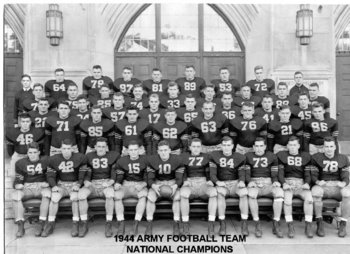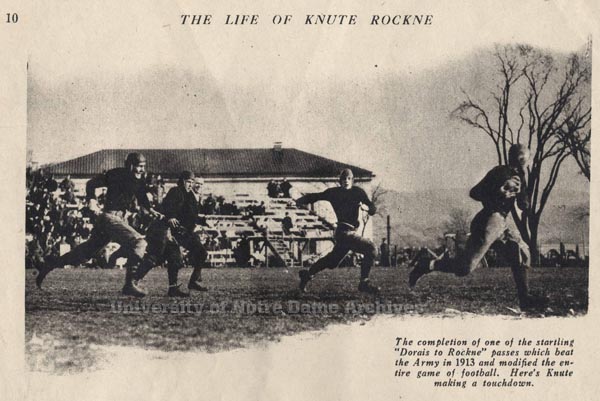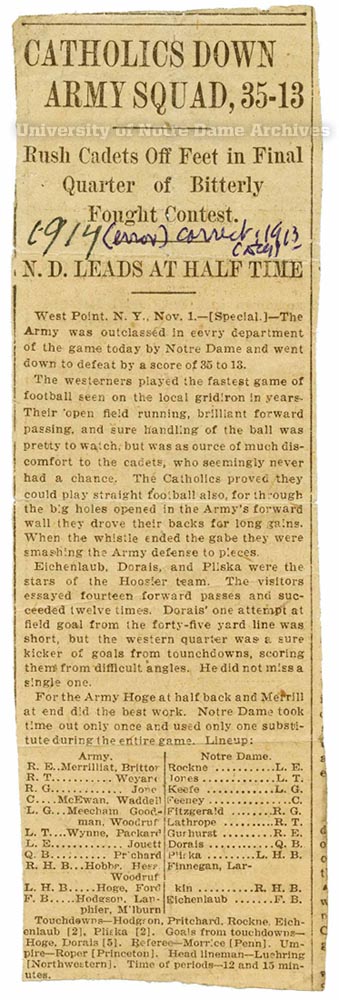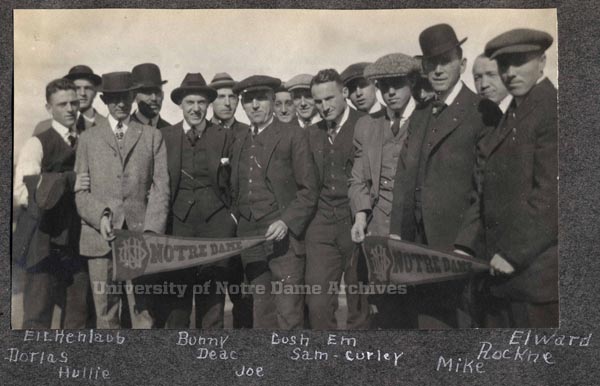A hundred years.
For almost
everyone in the world, that’s more than a lifetime ago. As the old Longfellow rhyme goes, hardly a
man is now alive who remembers the 1st of November, 1913. Needless to say, the world was quite
different then. Woodrow Wilson was
President, running hither and yon implementing segregationist policies. Prohibition was an up and coming idea. And Fielding Yost of Michigan was organizing
a regional boycott of a small school in northern Indiana because he hated
Catholics.
 |
| Noted nativist, bigot, and hilljack Fielding H. Yost was unavailable for this article, having been dead for quite some time. |
The boycott, as I covered earlier, began with a
cancellation of the 1910 Notre Dame-Michigan game at the 11th hour. This infuriated the members of that Notre
Dame team who had been looking forward to that game, most notably a Freshman
from Chicago named Knute Rockne. The dream of playing the premier team from the
West was dead.
Another thing about the world of 1913. This was a time when the schools that
constituted The Establishment were still very, very good at football. Princeton, Harvard, Yale, and Columbia all
competed for national championships in the sport. And on par with these Ivy League schools, a
destination for many scions of prominent Eastern families, was the United
States Military Academy at West Point. It’s
hard to wrap our heads around it nowadays, but Army produced over thirty
All-Americans, three national titles, and three Heisman Trophy winners in its
history. From the turn of the century to
the 1950s, they were one of the nation’s premier football teams.
 |
| One of several Army national championship teams |
Enter Notre Dame.
A small Catholic school hardly anyone in the country could find on the
map, its new coach decided to fight Yost’s blackballing the only way he
could. He scheduled the very best teams
in the country outside of Yost’s sphere of maleficence. And as the capstone of this suicide schedule,
he negotiated a deal with Army to travel across the country to upstate New York. Once again, I say, things were very different
then. Nowadays, Notre Dame goes on road
games carrying a semi trailer, emblazoned everywhere with the Notre Dame logo, full
of equipement along for the ride. In
1913, the players packed their own sandwiches and travelled by train, eighteen
football players traveling with fourteen pairs of football cleats to share
among themselves.
But on this trip they carried a secret, revolutionary
weapon. Football coaches had only
recently allowed players to advance the ball by throwing it downfield from the
quarterback to an end or receiver. Most
schools stayed away from this newfangled football weapon. Like the unfrozen caveman lawyer, the forward
pass confused them. A subset of them
used it only as a last resort, to move the ball downfield while down big at the
end of games. And an even tinier subset
of schools implemented pass plays where the receiver would run downfield, then
stop and wait for the ball.
That freshman from 1910 and his roommate Gus Dorais
changed all that. As lifeguards at Cedar
Point Ohio that summer, they practiced throwing a football back and forth to
each other on the shores of Lake Erie.
It must have looked absurd to the beachgoers: footballs were not to be
used that way. Everyone knew that. But they progressed from throwing to each
other while standing still to throwing towards a target running downfield. It was new, revolutionary, and as far as they
knew, Gus and Knute were the first ones to think of the concept.
 |
| Plaque in their honor, Cedar Point, Ohio. |
Coach Harper kept this new passing concept under wraps
for the entire season. Army, preparing
for its upcoming game against their archrivals at the Naval Academy, was
prepared for the usual football technique: line plunges, counters, end arounds,
maybe even a reverse if the offense was feeling especially frisky. Army wasn’t worried, though. Their line outweighed Notre Dame’s line by
fifteen pounds per man. Back then, when
an athlete over 200 pounds was notable indeed, this was a big, big difference.
Instead, Dorais opened up the passing attack, tossing a
pass eleven yards for a first down. Then
another, then another, and then a forty-yard touchdown pass. The Army was utterly confused. Not knowing how to defend the run and the
pass at the same time, Notre Dame switched back and forth at will, throwing the
ball until Army dropped back to stop the pass, and then smashing them in the
face with fullback dives until Army moved up to stop the run. Final Score, Notre Dame 35, Army 13.
It’s fair to say on that one fall day, a hundred years
ago, everything about college football changed in three hours. The forward pass was no longer a novelty or
some bit of newfangled nonsense: every team in the country would have to learn
how to use it and defend against it or lose horribly. The days of football-as-rugby were dead and
gone. Meanwhile, the headlines in New
York and across the country shouted the coming of a new day and a new team:
Yes, Catholics. For those were the
days of the WASP establishment, when the Ku Klux Klan would burn crosses on the
lawns of Catholics who would move out of ‘their’ neighborhoods and into one of ‘our’
neighborhoods. Notre Dame became more
than a little Catholic school in a little town in a state somewhere in the
middle of the country. It became a badge
of honor for Catholics across the country to cheer for Notre Dame, a school
they’d never seen in a state they’d never been to. Their team wasn’t the local university that shuffled
admissions to make sure the right sort got in and the wrong sort got left out. Their team was the Fighting Irish of Notre
Dame. A team fighting, to paraphrase the
fictional Buster Kilrain, not for equality, but for the right to prove they were better men than many of their foes.
And in support of this idea and this passion they turned out in
droves. The Subway Alumni became Notre
Dame’s staunchest supporters away from home.
While Army fans arrived for tilts against Notre Dame in New York City in
Cadillacs, De Sotos, Dussenbergs, and touring cars, Notre Dame’s fanbase
arrived in droves via subway, a deluge rising from the tunnels below the Polo
Grounds after a trip across New York from immigrant tenements across the
country. All, once again, for a school
they’d never seen, in a place they’d never been to. Of course, it didn’t stay that way
forever. Soon the children of these
Subway Alumni began to go off to college.
And more and more of them as the years went by went off to that little
place in a little state far away.
That place isn’t so
little anymore.
It has eight thousand
undergraduates, a colossal endowment, hundreds of alumni clubs across the
country, and dozens of study abroad programs around the world. But the road to becoming that big a presence,
that caliber of a university, and that big of a force for good in the world,
began one hundred years ago today on a football field in upstate New York.
Everyone, here’s to 171
years of Notre Dame, 126 years of Notre Dame Football, and 100 years, to the
day, of Dorais to Rockne and the Forward Pass.
Now let’s honor them
by stomping on Navy.






No comments:
Post a Comment